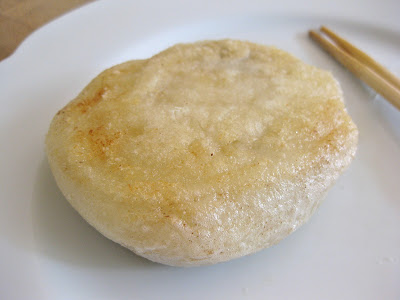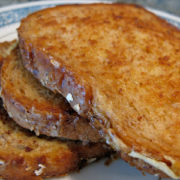One thing is notably missing from my life in Chicago – fresh mochi. I’m fortunate to have a Mitsuwa super-store within easy reach, which means plenty of Japanese grocery stapes, gadgets and tableware, and fresh baked goods.
And there are whole refrigerated cases of mochi at Mitsuwa, mostly daifuku – small, sweet mochi confections that are sometimes white but just as often daintily colored pink or green. But no fresh mochi.
They’re bigger than daifuku, and simpler – just pounded white rice surrounding an anko bean center, and very perishable.
One reliable source of fresh mochi is Suruki, the Japanese market in San Mateo. Pick up a package and press it ever so gently, and you’ll feel the mochi give way – it’s perfectly fresh. I like my mochi for breakfast, so I leave the package out on the counter overnight; in the morning, the mochi have already hardened a bit. If you need to keep them for longer than a day (or, say, transport them to Chicago), they must go into the refrigerator or the freezer – it will preserve them, but they’ll be hard, even when thawed.
All of which means: truly fresh mochi is a rare treat for me.
The best way to make mochi is to cook it very slowly in butter, in a small, covered pan. Check on it often – as my grandfather said, mochi is the perfect food when you’re hungry, since you can poke it as much as you’d like while waiting. The pounded rice becomes warm and sticky beneath a crisp, savory exterior; the anko beans provide soft, sweet contrast.
It takes a long time to eat this kind of mochi, so it’s ideal for a leisurely breakfast with lots of contemplative chewing. And afterwards, I have energy to get through the whole morning, without the slightest hungry stomach rumble.

 Shakshuka (baked eggs)
Shakshuka (baked eggs) Breakfast at the Carneros Inn (Boon Fly and Hilltop)
Breakfast at the Carneros Inn (Boon Fly and Hilltop) Egg in the hole
Egg in the hole Ojiichan’s French toast
Ojiichan’s French toast